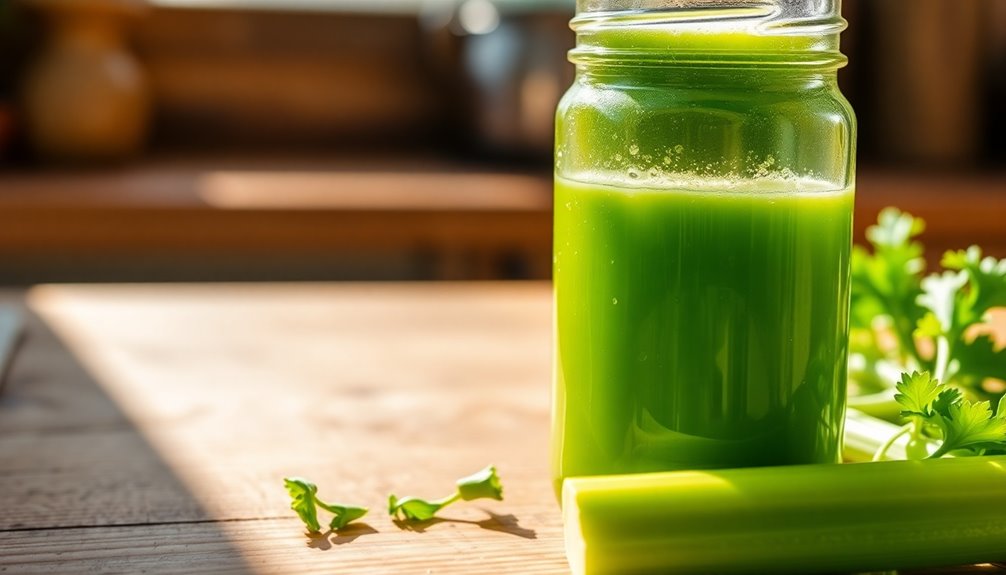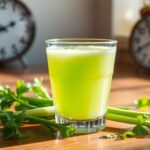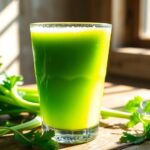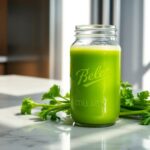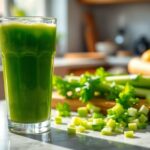Celery juice is good for about 24 to 72 hours in the fridge if you store it properly. To maximize freshness, use an airtight container and refrigerate it promptly after juicing. Aim to drink it within the first 24 hours for the best flavor and health benefits. Watch out for signs of spoilage like off smells or discoloration. Want to know more about storage tips and health benefits? Keep exploring!
Key Takeaways
- Fresh celery juice is best consumed within 24 hours for optimal flavor and nutritional value.
- It can last 24 to 72 hours in the refrigerator if stored properly.
- Use an airtight container to maintain freshness and prevent spoilage.
- Signs of spoilage include off smell, discoloration, and visible mold.
- Prompt refrigeration after juicing is crucial for extending shelf life and safety.
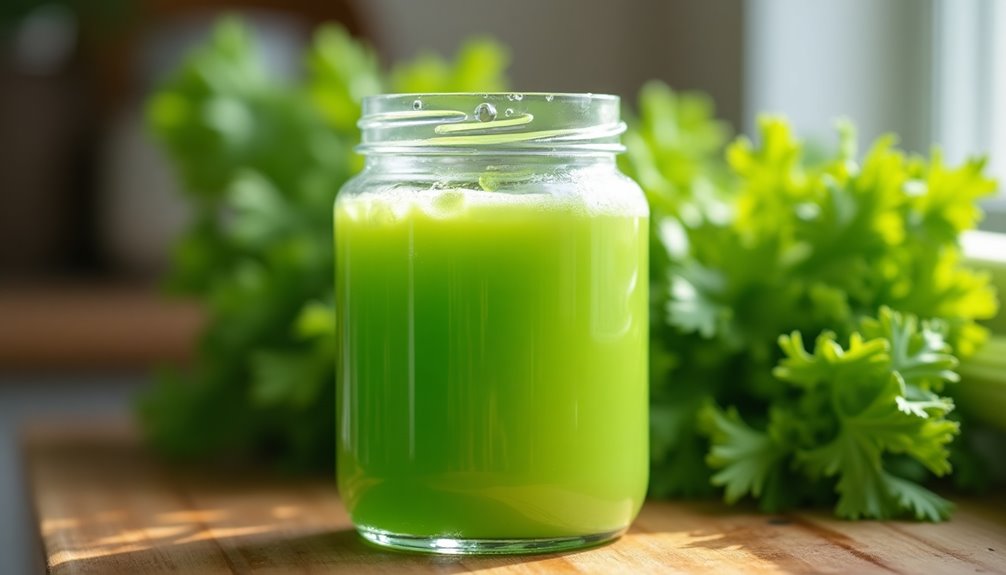
Have you ever wondered how long celery juice stays fresh in the fridge? If you've just made a batch of fresh celery juice, you'll want to know how best to store it to maximize its shelf life. Properly stored, celery juice can last anywhere from 24 to 72 hours in your refrigerator. To ensure you get the most health benefits and optimal taste, it's essential to follow a few simple guidelines.
First off, prompt refrigeration is crucial. As soon as you've juiced your celery, you should place it in an airtight container and pop it in the fridge right away. Any delay in refrigeration can significantly reduce the shelf life of your juice, and no one wants to drink spoiled juice! If you take this step, your fresh celery juice can remain safe for consumption for up to three days.
However, for the best flavor and nutritional value, it's recommended to consume it within the first 24 hours.
When you store your celery juice, make sure to use an airtight container. This keeps out air and other contaminants that can cause your juice to go bad more quickly. Containers that seal tightly help to maintain the freshness of your juice, ensuring it retains its vibrant color and taste.
If you open the container frequently or leave it exposed, you might find that the shelf life of celery juice diminishes.
While you might be tempted to save your juice for later, it's important to recognize the signs that it's no longer good to drink. If your celery juice has an off smell, shows discoloration, or has visible mold, it's time to toss it. These signs indicate spoilage, and consuming bad juice can lead to unpleasant digestive issues.
Remember, the health benefits of fresh celery juice can quickly disappear if you're not careful about how you store it.
Even though you can technically keep celery juice for up to three days when stored properly, the best practice is to enjoy it as soon as possible. Fresh celery juice is packed with nutrients and can provide a refreshing boost, but its quality diminishes over time.
If you're looking for the optimal taste and health advantages, aim to drink your juice within the first 24 hours after juicing.
Frequently Asked Questions
How Do You Know if Celery Juice Has Gone Bad?
To know if your celery juice has gone bad, look for changes in color, like browning or yellowing, which indicates oxidation.
Pay attention to any sour or unpleasant smells; if it smells off, don't drink it.
Taste is also important—if it tastes significantly different or unpleasant, it's best to discard it.
Finally, check for visible mold on the surface; if you see it, throw the juice away immediately.
Can You Prep Celery Juice for the Week?
Yes, you can prep celery juice for the week! Just make sure to store it in airtight containers to protect its freshness.
It's best to consume it within 24-48 hours for optimal taste and nutrition. If you're planning on making larger batches, consider portioning them into individual servings.
Remember to refrigerate it right after juicing to keep it from spoiling quickly, and avoid leaving it at room temperature for too long.
How Long Does Juice Last in the Fridge After Juicing?
Juice can't last forever, but it can feel like a magical elixir in your fridge!
After juicing, your fresh juice will stay good for about 24 to 72 hours if you store it in an airtight container. To maximize freshness, it’s best to keep your juice refrigerated and to consume it as soon as possible. When considering how long does juice last, remember that exposure to light and air can significantly degrade its quality and nutritional value over time. If you’re unsure about its freshness, always rely on your senses—look for changes in color, smell, and taste before deciding to drink it.
Remember, it's crucial to refrigerate it right away, as it spoils quickly at room temperature.
Always check for off smells or discoloration before drinking; those are your signs it's time to toss it out!
How Long Should You Not Eat After Celery Juice?
After drinking celery juice, you should wait at least 15 to 30 minutes before eating solid food.
This allows your body to fully absorb the nutrients and promotes better digestion. Some experts even recommend waiting up to 2 hours for maximum benefits, especially for gut health.
Listen to your body—if you feel bloated or uncomfortable, adjust your timing. Staying hydrated before and after drinking celery juice is also essential for optimal digestion.
Conclusion
In the cool embrace of your fridge, freshly juiced celery can stay vibrant for about 72 hours. After that, it starts to lose its crisp charm and nutritional benefits, much like a wilting flower. To savor its refreshing green goodness, drink it within this time frame. If you notice any changes in color or smell, it's best to toss it out. Keep your juice as lively as a sunlit garden, and enjoy its benefits while it's still fresh!
Cindy thoroughly researches juicing trends, techniques, and recipes to provide readers with practical advice and inspiration. Her writing style is accessible, engaging, and designed to make complex concepts easy to understand. Cindy’s dedication to promoting the advantages of juicing shines through her work, empowering readers to make positive changes in their lives through the simple act of juicing.

